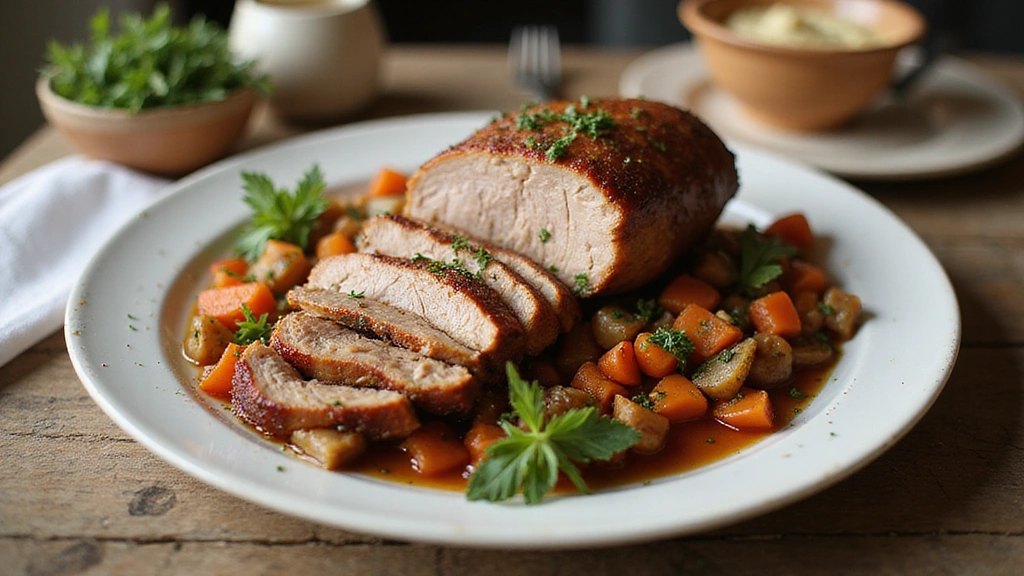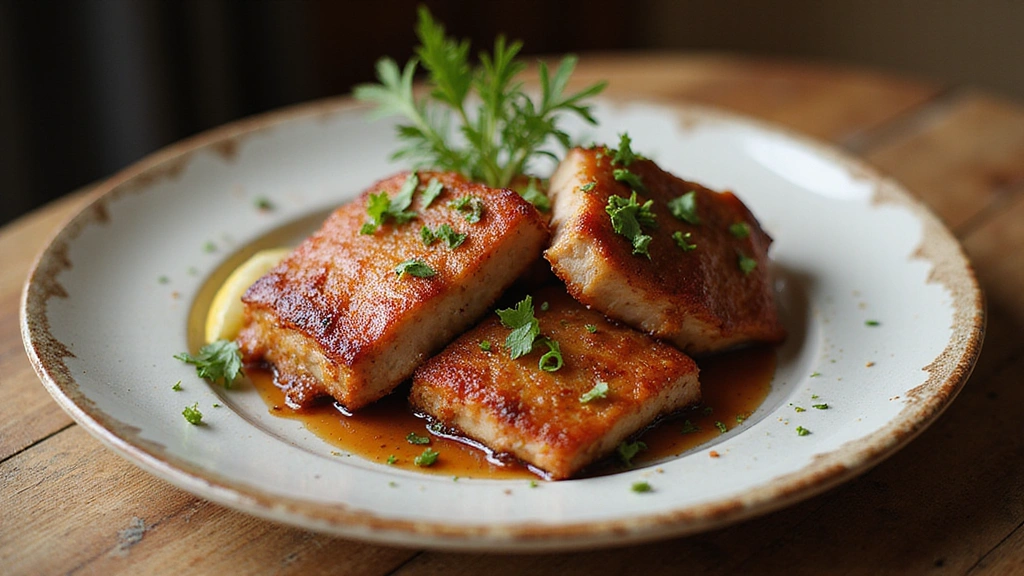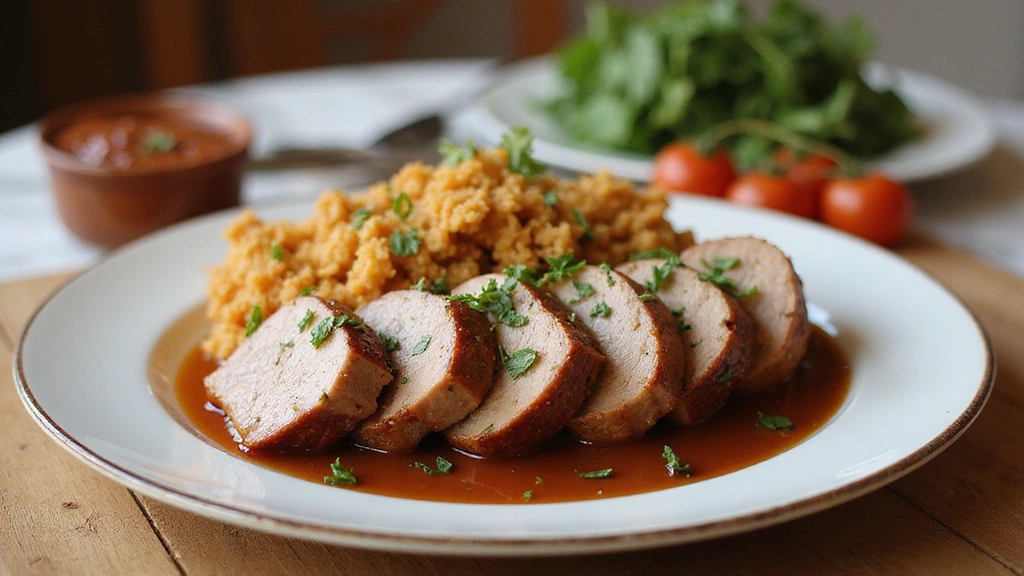
Ingredients
Equipment
Method
- Step 1: Prepare Ingredients
- Step 2: Preheat Oven
- Step 3: Sear the Pork
- Step 4: Prepare Herb Rub
- Step 5: Arrange Vegetables
Notes
This classic Pork Roast Recipe brings together centuries of culinary tradition with modern techniques to create a dish that’s both comforting and elegant.
The harmonious balance of savory herbs and succulent pork creates a memorable dining experience that will have everyone asking for your secret.
I discovered this recipe during my travels through Bavaria, where local chefs have perfected it through generations of careful refinement.
Whether you’re preparing a casual family dinner or hosting a special celebration, this Pork Roast Recipe delivers impressive results with straightforward preparation.
The History and Cultural Significance
• Pork Roast Recipes trace their origins to medieval Europe, where it was originally created by local farmers using simple, hearty ingredients.
• The dish evolved over decades as cooking methods improved, eventually becoming the beloved version we know today with the introduction of new spices and techniques.
• In Germany, this dish traditionally appears at festive gatherings, symbolizing abundance and family unity.
• While many variations exist across different regions, the authentic version maintains a balance of savory and aromatic flavors that sets it apart from imitations.
Recipe Overview
Nutritional Information (per serving)
Essential Equipment Guide
Roasting Pan: A heavy-duty roasting pan ensures even cooking and allows the pork to develop a crispy exterior. Alternatives include a deep baking dish, but ensure it has high sides to prevent juices from spilling.
Meat Thermometer: This tool is crucial for achieving the perfect level of doneness without overcooking. Look for digital models for precise readings. An alternative is a classic dial thermometer, though it may be less accurate.
Tongs: Essential for turning the pork and managing its placement in the pan without piercing the meat, which helps retain juices. Silicone-tipped tongs provide a non-slip grip and are gentle on the meat.
Ingredients
For the Base
| Amount | Ingredient | Notes |
|---|---|---|
| 4 pounds | pork loin | trimmed of excess fat |
| 2 tablespoons | olive oil | for searing |
Seasonings
| Amount | Ingredient | Notes |
|---|---|---|
| 3 cloves | garlic | minced, for depth of flavor |
| 1 tablespoon | fresh rosemary | chopped, adds aroma |
| 1 tablespoon | fresh thyme | chopped, complements pork |
| 1 teaspoon | salt | enhances flavor |
| 1 teaspoon | black pepper | freshly ground, for spice |
Vegetables
| Amount | Ingredient | Notes |
|---|---|---|
| 2 large | carrots | peeled and cut into chunks |
| 2 large | onions | quartered |
| 3 stalks | celery | cut into pieces |
Preparation Methods
Searing: Searing the pork on high heat before roasting is crucial to lock in juices and create a flavorful crust. Use a hot pan with oil and sear each side until golden brown, about 3-4 minutes per side.
Herb Rub: Creating an herb rub with fresh ingredients like rosemary and thyme infuses the pork with deep, aromatic flavors. Rub generously over the entire surface of the pork, pressing gently to adhere.
Resting: Allowing the roasted pork to rest after cooking redistributes the juices, ensuring a tender and moist texture. Cover loosely with foil and let it rest for at least 10 minutes before slicing.
Step 1: Prepare Ingredients

Gather all ingredients and equipment needed for the recipe.
Peel and chop the vegetables as described in the ingredients list.
Trim any excess fat from the pork loin to prevent excessive greasiness.
Ensure all seasonings are measured and ready for use.
Step 2: Preheat Oven

Set your oven to 375°F (190°C) to ensure it's hot when the pork is ready.
Position the oven rack in the center to allow even heat distribution.
Check that the oven is free of any previous dishes or racks that could obstruct airflow.
Allow the oven to preheat for at least 10 minutes before baking.
Step 3: Sear the Pork

Heat olive oil in a large skillet over medium-high heat until shimmering.
Add the pork loin and sear on each side for 3-4 minutes until a golden crust forms.
Use tongs to turn the pork, avoiding puncturing the meat.
Remove from heat and let it rest while you prepare the roasting pan.
Step 4: Prepare Herb Rub

In a small bowl, combine minced garlic, rosemary, thyme, salt, and pepper.
Mix thoroughly to create a uniform herb mixture.
Use your hands to rub the mixture evenly over the entire surface of the pork loin.
Ensure all sides are coated for even flavor distribution.
Step 5: Arrange Vegetables

Spread the chopped vegetables evenly in the bottom of the roasting pan.
Ensure they are in a single layer to promote even roasting.
Drizzle with a little olive oil to enhance browning and flavor.
Toss gently to coat the vegetables in oil.
Step 6: Roast the Pork

Place the seared pork loin on top of the vegetable layer in the roasting pan.
Insert a meat thermometer into the thickest part of the pork to monitor doneness.
Transfer the pan to the preheated oven and roast for about 90 minutes.
Check periodically to ensure even cooking and prevent drying out.
Step 7: Check Doneness

After 90 minutes, check the internal temperature of the pork.
It should reach 145°F (63°C) for safe consumption.
If needed, continue roasting in 5-minute increments until the desired temperature is reached.
Remove from the oven once properly cooked.
Step 8: Rest and Serve

Transfer the pork to a cutting board and cover loosely with foil.
Let it rest for at least 10 minutes to allow juices to redistribute.
Slice the pork against the grain into even portions.
Serve with roasted vegetables and garnish with fresh herbs if desired.
Critical Timing and Temperature Guide
Searing: Sear each side of the pork for 3-4 minutes on high heat until a golden crust develops. Avoid overcrowding the pan, which can prevent proper browning.
Roasting: Roast at 375°F (190°C) for approximately 90 minutes, or until the internal temperature reaches 145°F (63°C). Ensure the oven maintains a consistent temperature for even cooking.
Resting: Allow the pork to rest for at least 10 minutes after cooking. This period is crucial for tender, juicy meat. Avoid slicing too early, which can cause juices to escape.
Pro Tips for Pork Roast Recipes
• Ingredient Selection: Choose a high-quality pork loin, preferably with a good amount of marbling for flavor and juiciness.
• Preparation Secret: Dry the pork with paper towels before searing to enhance the crust formation.
• Temperature Management: Bring the pork to room temperature before searing to ensure even cooking.
• Texture Enhancement: Use a sharp knife to make clean, even slices against the grain for the tenderest texture.
• Flavor Layering: Marinate the pork overnight with the herb rub for deeper flavor infusion.
• Make-Ahead Strategies: Prepare and chop all vegetables a day in advance, storing them in an airtight container in the fridge.
• Restaurant-Quality Finishing Touches: Drizzle with a reduction of pan juices for added depth and shine.
• Equipment Optimization: Preheat your roasting pan in the oven to start the roasting process with an immediate heat source.
Troubleshooting Common Issues
• Texture Too Tough: Overcooking can lead to toughness. Use a meat thermometer to check doneness and avoid cooking beyond 145°F.
• Flavors Unbalanced: Ensure proper seasoning proportions and let the pork marinate with herbs to balance flavors.
• Vegetables Undercooked: Cut vegetables into smaller pieces to ensure they roast evenly with the pork.
• Pork Too Dry: Searing properly and resting the meat are crucial to retaining moisture. Ensure these steps are not skipped.
• Crust Not Formed: Make sure the pork is dry before searing, and the pan is hot enough to develop a crust quickly.
Variations and Regional Differences
• Italian Style: Includes the addition of fennel seeds and lemon zest in the herb rub, paired with roasted potatoes instead of vegetables.
• Korean Bulgogi: Uses a marinade of soy sauce, garlic, ginger, and sesame oil, with the pork thinly sliced before roasting.
• American Southern Style: Incorporates a sweet and spicy glaze made from brown sugar and cayenne pepper, served with cornbread.
• Caribbean Jerk: Features a spicy rub of allspice, scotch bonnet peppers, and thyme, often served with fried plantains.
Food Science Behind the Recipe
• Maillard Reaction: The browning that occurs during searing enhances flavor through complex chemical reactions between amino acids and reducing sugars.
• Protein Denaturation: Cooking causes proteins to uncoil and recombine, transforming the texture of the pork from raw to tender.
• Moisture Retention: Resting the meat allows muscle fibers to reabsorb juices, preventing dryness when slicing.
Frequently Asked Questions
What's the most common mistake people make when preparing pork roast? Overcooking is the most common mistake, leading to dry, tough meat. Using a meat thermometer helps prevent this.
Can I use frozen pork loin for this recipe? It's best to thaw the pork completely before cooking for even heat distribution and proper searing.
How can I add more flavor to my pork roast? Marinating the pork overnight with your herb rub can enhance the depth of flavor significantly.
What should I do if my roast is cooking unevenly? Rotate the pan halfway through roasting to ensure even heat exposure.
How can I make the crust more pronounced? Ensure the pork is dry before searing and use a hot pan to quickly develop a crust.
Can I substitute other meats for pork in this recipe? Yes, similar cuts of beef or lamb can be used, but cooking times may vary.
Is there a way to make this recipe more diet-friendly? Reduce the fat content by trimming more fat from the pork and using less oil during cooking.
Serving and Presentation Guide
• Traditional Presentation: Serve sliced pork on a large platter with roasted vegetables around the edges, garnished with fresh herbs.
• Family Style: Arrange slices on a wooden board with a small bowl of pan juices for dipping, encouraging communal sharing.
• Gourmet Touch: Plate individually with a drizzle of balsamic reduction and a sprig of rosemary for elegance.
• Casual Buffet: Present on a warming tray alongside various sides, allowing guests to serve themselves.
Conclusion
This Pork Roast Recipe is not just a meal; it's an experience that bridges tradition and modern taste.
By following these detailed steps, you'll create a dish that is both flavorful and tender, perfect for any occasion.
Embark on this culinary journey and delight in the rich, savory flavors that this classic dish has to offer.




